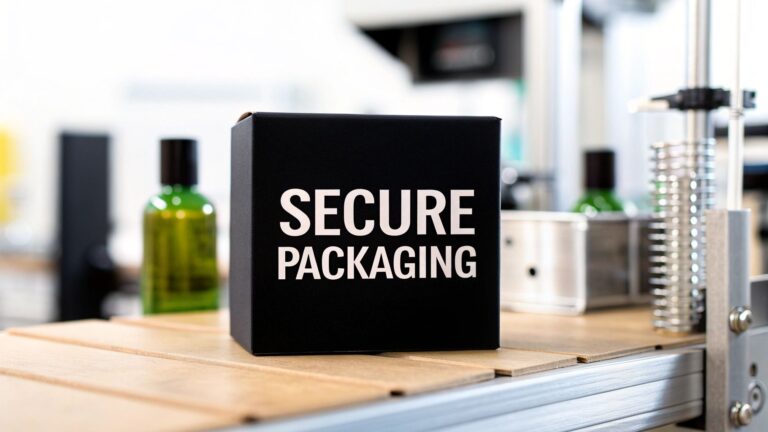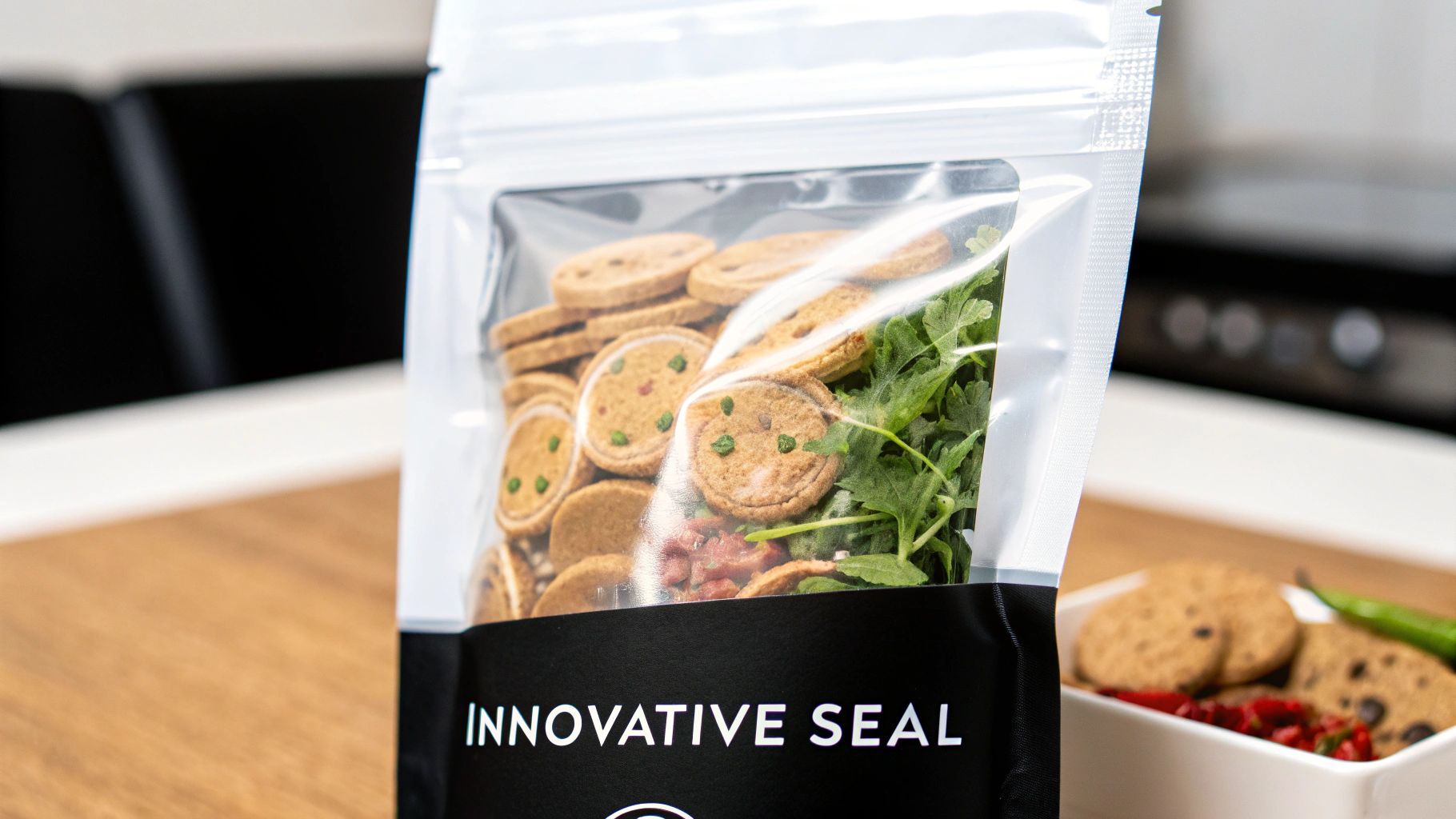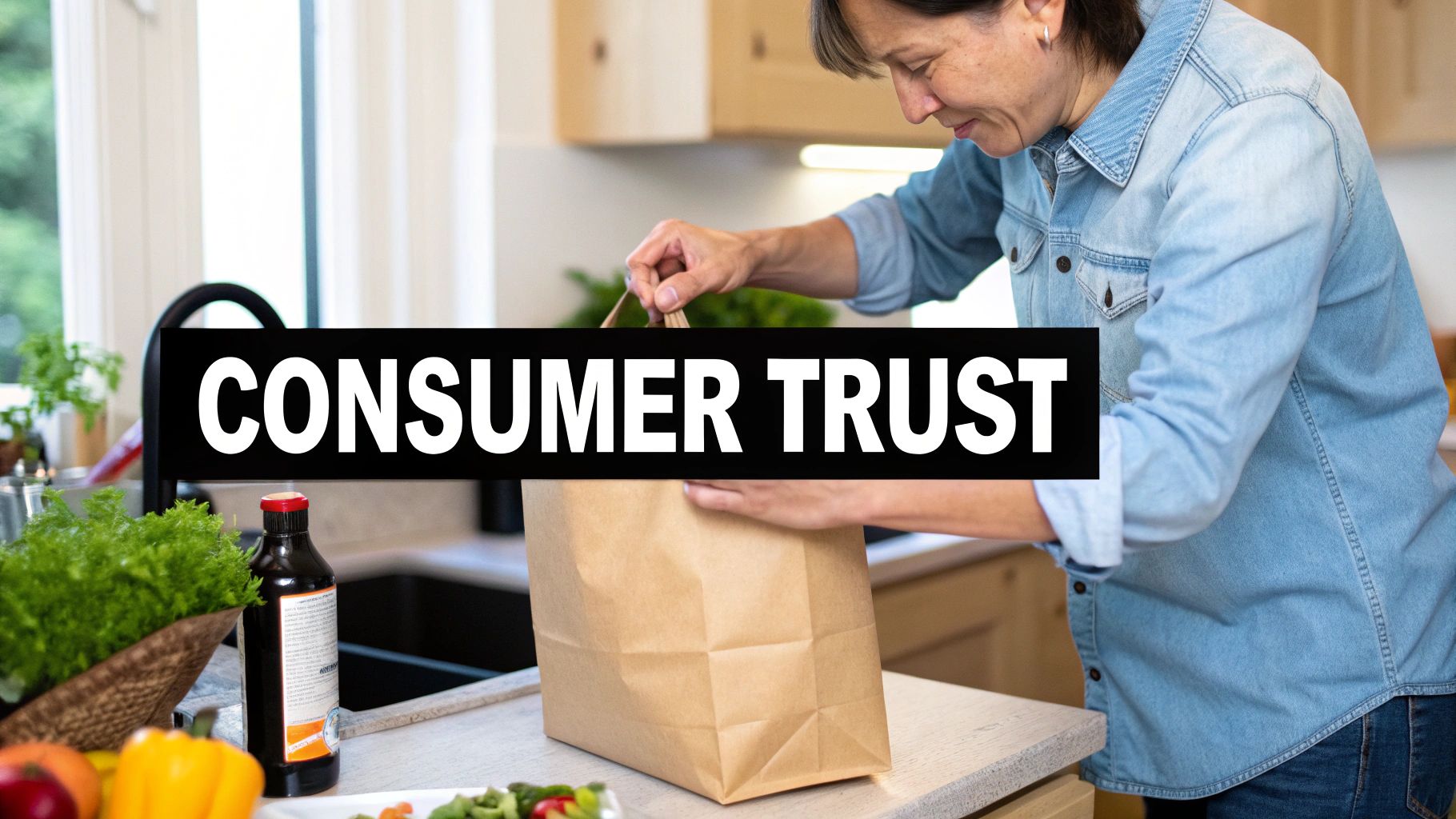Demystifying Tamper Resistant Packaging: Beyond the Basics
Tamper resistant packaging is vital for safeguarding product integrity and building consumer trust. It’s more than just a simple seal; it’s a comprehensive system designed to protect products from unauthorized access and potential contamination. This protection spans various industries, from pharmaceuticals and food to consumer goods and beyond. Let’s explore the intricacies of tamper resistant packaging.
Understanding the Different Levels of Protection
One area that often confuses is the distinction between tamper-evident, tamper-resistant, and tamper-proof packaging. Tamper-evident packaging offers visible signs if a package has been opened, like a broken seal or torn shrink wrap. This acts as both a deterrent and an alert for consumers.
Tamper-resistant packaging, meanwhile, is designed to make accessing the product significantly more difficult. This often involves stronger materials and more intricate closures, such as blister packs for medications or induction-sealed jars.
Finally, tamper-proof packaging aims to make opening a package virtually impossible without specialized tools or leaving clear evidence of forced entry. This high level of security is typically reserved for high-value or extremely sensitive items.
The Psychology of Security Packaging
Tamper resistant packaging serves a dual purpose: it creates a physical barrier and acts as a psychological deterrent. The very presence of security features can discourage potential tampering. Clear indicators of tampering also prevent consumers from using a compromised product.
This builds consumer trust and reinforces the brand’s commitment to safety and quality. This is particularly critical in the food and pharmaceutical industries, where consumer confidence is paramount.
Market Growth and Trends
The market for tamper-evident packaging is growing, driven by both regulations and increasing consumer awareness. In 2023, the global market was valued at $2.2 billion. It’s projected to grow at an 8.5% CAGR through 2032.
This growth reflects rising regulatory requirements and consumer demand for product integrity. By 2025, the market is expected to hit $2.34 billion. Specialized segments, such as pharmaceutical tamper-proof packaging, already reached $13.4 billion in 2024.
E-commerce growth is a key driver, as online retail requires secure packaging to prevent tampering and counterfeiting during shipping. North America currently leads the market due to strict FDA regulations. However, the Asia Pacific region is the fastest-growing, fueled by India’s expanding pharmaceutical industry and China’s demand for anti-counterfeit packaging in e-commerce.
Here’s a table that summarizes the various types of tamper-resistant packaging solutions available:
Types of Tamper Resistant Packaging Solutions
| Packaging Type | Primary Applications | Protection Level | Consumer Visibility | Cost Range |
|---|---|---|---|---|
| Shrink Wrap | Food, consumer goods | Low (tamper-evident) | High | Low |
| Breakaway Seals | Bottles, jars | Medium (tamper-evident) | High | Low-Medium |
| Blister Packs | Pharmaceuticals, electronics | High (tamper-resistant) | High | Medium-High |
| Induction Seals | Food, pharmaceuticals | High (tamper-resistant) | Medium | Medium |
| Tamper-Proof Bags | Cash, sensitive documents | Very High (tamper-proof) | High | High |
This table highlights the diverse range of solutions available, each offering different levels of protection and visibility. Choosing the right packaging depends on the specific product and industry requirements.
Investing in robust security measures not only protects products but also strengthens brand reputation and encourages consumer loyalty. This proactive approach showcases a commitment to quality and safety, building consumer trust and strengthening brand image.
Pharmaceutical Protection: Where Tamper Resistant Packaging Saves Lives
In the pharmaceutical industry, product integrity is paramount. It’s not just about brand reputation—it’s a matter of patient safety and, in many cases, life and death. Tamper resistant packaging plays a vital role in safeguarding medications from counterfeiting and ensuring their efficacy. This goes beyond simply deterring casual tampering; it involves comprehensive strategies to combat organized criminal activity.
Multi-Layered Security for Pharmaceuticals
Modern pharmaceutical packaging utilizes a multi-layered security approach, incorporating numerous features to protect against various tampering methods. This layered approach strengthens the overall security of the product.
- Blister packs: These individualized doses provide excellent protection and allow for easy visual inspection for any signs of tampering.
- Bottle closures: Specialized caps with tamper-evident seals offer an additional layer of security, especially for liquid medications.
- Authentication systems: Technologies such as holograms and unique serial numbers help verify product authenticity and origin.
These systems work together to create a robust defense against counterfeiting, keeping potentially harmful substances out of the hands of patients.
Balancing Security and Accessibility
A key challenge in pharmaceutical packaging is finding the right balance between strong security and patient accessibility. Senior citizens and those with disabilities may find complex packaging designs difficult to manage. However, tamper-resistant packaging innovations strive to provide clear evidence of tampering without hindering legitimate users’ access to their medications. User-friendly designs are prioritized to prevent security measures from becoming an obstacle for patients.
Investing in the Future of Pharmaceutical Safety
Pharmaceutical companies are continuously investing in new technologies to combat counterfeiters and enhance patient safety. Research into advanced materials, smart packaging, and track-and-trace systems is ongoing. These advancements represent significant progress in securing the pharmaceutical supply chain. Moreover, the rising need for cold chain logistics for sensitive medications and biologics further fuels innovation in tamper resistant solutions. These solutions must maintain product integrity even under challenging storage and transportation conditions.
This specialization comes at a price. The pharmaceutical tamper-proof packaging market represents a substantial segment, valued at $13.4 billion in 2024. Projections indicate this market will reach $24.6 billion by 2034, growing at a 6.4% CAGR. The industry has navigated challenges such as the 25% U.S. import tariffs on packaging materials from China, Canada, and Mexico imposed during the Trump administration. These tariffs increased costs for essential components like blister packs and induction seals, impacting generic drug manufacturers significantly. This prompted companies like Novartis to invest in U.S.-based packaging facilities, highlighting the evolving supply chain strategies in this sector.
The Role of Regulations and Standards
Stringent regulations and industry standards are essential for effective tamper resistant packaging. These regulations, often developed in response to past incidents, help ensure a high level of safety. They also provide a framework for continuous improvement in packaging design and technology.
In conclusion, tamper resistant packaging in the pharmaceutical industry is a constantly evolving field. The driving force behind this evolution is the crucial need to protect patients and the integrity of essential medications. Continuous advancements in this area demonstrate the industry’s commitment to patient safety and the ongoing fight against counterfeiting and tampering.
Food & Beverage Security: Balancing Safety with Accessibility
Food and beverage manufacturers face a difficult task: creating tamper-resistant packaging that keeps products safe while remaining user-friendly. Unlike the pharmaceutical industry, where complex packaging is commonplace, food packaging needs to be accessible to everyone, while still clearly showing if it’s been tampered with. This requires finding a perfect balance between robust security and easy accessibility.
Striking a Balance Between Security and Usability
Achieving this balance is crucial for food brands. Overly complicated packaging can frustrate customers and hurt a brand’s image. For example, struggling to open a jar of pasta sauce might discourage repeat purchases, even if the jar is secure. On the other hand, packaging that is too easy to open can compromise product safety and damage consumer trust. Therefore, packaging design requires careful consideration, focusing on obvious tamper-evident features without making it difficult for consumers to open.
Tamper-Evident Technologies in Food Packaging
Several tamper-evident technologies are very effective for various food products:
- Vacuum seals: These provide strong evidence of tampering while keeping products like meat and cheese fresh. A broken seal clearly indicates a problem.
- Induction seals: Often used for jars and bottles, induction seals create an airtight barrier that is easy to spot if broken, assuring consumers of product integrity.
- Tamper-evident tapes: These specially designed tapes leave a mark or tear when removed, clearly showing if someone has tried to open a carton or other package. This acts as a deterrent and highlights tampering attempts.
- Innovative cap designs: Flip-top caps with tamper-evident rings or seals give consumers a visual confirmation that the package is unopened, combining functionality with obvious security features.
Implementation Strategies for Secure Packaging
Implementing secure packaging doesn’t have to be expensive or drive customers away. Here are some key strategies:
- Prioritize high-risk products: Focus on products that are more likely to be tampered with or pose higher safety risks, such as baby food or ready-to-eat meals.
- Phased implementation: Introduce tamper-resistant packaging gradually to gauge consumer reactions and adjust designs based on feedback. This allows for practical adjustments.
- Consumer education: Explain the benefits of tamper-resistant packaging to consumers, emphasizing its role in protecting their safety and product quality. Clear communication can ease any worries about more complex packaging.
Measuring the Impact of Tamper-Resistant Packaging
Using tamper-resistant packaging effectively can greatly improve both safety and customer satisfaction, resulting in real benefits for food businesses:
- Reduced product recalls: Secure packaging lowers the chance of contaminated products reaching consumers, resulting in fewer expensive recalls.
- Increased consumer confidence: Clear tamper-evident features build trust and brand loyalty, leading to repeat purchases and a positive brand image.
- Improved brand reputation: A commitment to product safety improves a brand’s image and strengthens its market position, showing customers that the brand cares about their well-being.
The following table illustrates how different food categories use various tamper-resistant packaging methods.
Tamper Resistant Packaging Applications Across Food Categories
| Food Category | Common Tampering Risks | Preferred Packaging Solutions | Consumer Acceptance | Implementation Challenges |
|---|---|---|---|---|
| Dairy | Contamination, spoilage | Vacuum seals, tamper-evident lids | High | Maintaining seal integrity during transport |
| Beverages | Adulteration, product substitution | Induction seals, tamper-evident caps | High | Ensuring easy opening for various consumer demographics |
| Ready-to-Eat Meals | Contamination, tampering | Tamper-evident films, microwaveable seals | Moderate | Balancing security with ease of heating and consumption |
| Baby Food | Product tampering, contamination | Tamper-evident jars, pouches with safety features | High | Designing child-resistant but parent-friendly packaging |
| Confectionery | Product tampering, theft | Tamper-evident wrappers, sealed boxes | Moderate | Cost-effectiveness for lower-priced items |
By strategically implementing these measures, food and beverage manufacturers can strike a balance between strong security and consumer convenience. This approach protects consumers, builds trust, and fosters brand loyalty.
Market Dynamics: Following the Money in Packaging Security
The tamper-resistant packaging market is booming, impacting businesses worldwide. Understanding these market forces is crucial for smart packaging investments. This involves analyzing investment trends and their impact on package security innovation.
Regional Growth and Adoption of Tamper-Resistant Packaging
Growth in tamper-resistant packaging varies widely by region, reflecting different regulations, economies, and consumer preferences. India’s tamper-evident market, for example, sees a 5.8% CAGR, driven by growth in the FMCG and pharmaceutical sectors.
Germany’s 3.3% growth, in contrast, reflects strict EU compliance standards. China’s 5% growth is fueled by booming e-commerce, with over 800 million digital buyers demanding anti-counterfeit measures. Technologies like QR codes and RFID tags are also key drivers, enabling real-time product authentication, especially for premium goods and medical devices. These regional differences underscore the need to tailor packaging strategies to specific market needs.
Industry-Specific Investments in Packaging Security
Investment in tamper-resistant packaging is especially strong where product integrity matters most: pharmaceuticals, food and beverage, and high-value consumer goods. The pharmaceutical industry, for example, invests heavily in tamper-proof solutions to combat counterfeiting and ensure patient safety.
The food and beverage sector is also adopting tamper-evident technologies to guarantee product freshness and safety. This increased security focus reflects growing consumer awareness and demand for product protection, helping solidify your brand as an authority.
Economic Factors Influencing Implementation Decisions
Cost is a key factor in how companies implement tamper-resistant packaging. Cost-benefit analysis helps justify security investments. Calculating the potential cost of product recalls due to tampering against the cost of preventative measures can demonstrate the value of tamper-resistant packaging.
Phased implementation allows companies to gradually introduce security features, managing upfront costs. This approach is particularly helpful for smaller businesses or those with tighter budgets, offering a balanced approach to security without jeopardizing financial stability.
Emerging Technologies and Competitive Advantages
Emerging technologies are set to reshape the tamper-resistant packaging market. Innovations like blockchain verification and connected packaging offer exciting possibilities for enhanced security and traceability. Early adopters can gain a competitive edge by providing superior product protection and transparency.
This forward-thinking approach positions businesses as leaders in product safety. These new technologies can also boost consumer engagement through interactive features and product information access.
Beyond Barriers: Tech Innovations Transforming Package Security
Physical tamper resistance, like strong seals and closures, is only the first layer of comprehensive product protection. Digital technologies are adding new security capabilities to tamper-resistant packaging, enhancing physical security with digital verification and tracking. Let’s explore how these innovations are changing the landscape of package security.
The Rise of Digital Tracking and Verification
Brands are increasingly integrating digital solutions into their packaging strategies to create multi-layered protection. This interconnected system boosts security and provides valuable data throughout the supply chain.
- RFID Tracking: Radio-frequency identification (RFID) tags embedded in packaging allow real-time tracking of products throughout the supply chain. This helps pinpoint potential tampering or diversion. Imagine a pharmaceutical company tracking medication from the factory to the pharmacy, verifying its integrity at every step.
- Blockchain Verification: Blockchain technology creates a permanent, unchangeable record of a product’s journey, making counterfeiting extremely difficult. Consumers can scan a package code to verify authenticity and origin, building trust and confirming legitimacy.
- Connected Packaging: Smart packaging with embedded sensors can monitor environmental conditions, like temperature and humidity, throughout the supply chain. This ensures product quality and flags any deviations that might indicate tampering or mishandling.
Empowering Consumers with Smartphone Authentication
Leading companies are transforming consumers into active participants in security. Smartphone authentication lets consumers scan a package code to instantly verify its authenticity, giving them direct control over security verification and fostering trust in the product.
Emerging Technologies: Photonic Crystals and AI
The future of tamper-resistant packaging holds exciting potential. Emerging technologies promise to further revolutionize the field, offering even stronger security measures.
- Photonic Crystals: These microscopic structures create unique, iridescent patterns that are nearly impossible to copy, making them perfect for authentication. Think of them as a unique fingerprint for each package, forming a robust defense against counterfeiting.
- AI-Based Verification Systems: Artificial intelligence (AI) can analyze images and data from multiple sources to detect subtle signs of tampering that might be missed by human eyes. This boosts detection accuracy and enhances the overall security of tamper-resistant packaging systems.
Separating Genuine Security from Illusion
Not all tamper-resistant features are equally effective. Some provide genuine security, while others offer only a superficial appearance of protection. Understanding this difference is crucial for both businesses and consumers. For example, strong seals provide clear tamper evidence, while simple tear strips might not offer enough security for valuable or sensitive items.
Effective tamper-resistant packaging requires a comprehensive strategy. Combining physical barriers with digital technologies and consumer engagement provides the most robust protection against tampering and counterfeiting. This integrated approach demonstrates a commitment to product safety and strengthens consumer confidence.
Navigating the Regulatory Maze of Tamper-Resistant Packaging
Tamper-resistant packaging isn’t just a smart business move; it’s essential for navigating a complex web of regulations designed to keep consumers safe. Non-compliance can have serious consequences, damaging your brand’s reputation and leading to expensive legal issues. This section will help you understand this regulatory landscape and the requirements that are most important for your products.
Key Regulations and Standards
Different regulations apply depending on your industry and where you sell your products. In the United States, the Food and Drug Administration (FDA) sets strict rules for tamper-evident packaging for certain food, drug, and cosmetic products. These regulations were largely implemented after the 1982 Tylenol tampering incident, a tragedy that highlighted the vital importance of product safety. Industry-specific standards, like those from the Packaging Association, offer additional guidance.
For example, over-the-counter medications often require tamper-evident seals on bottles and blister packs. Certain food products need seals or wrappers that clearly show if the packaging has been opened. Ignoring these requirements isn’t an option; it’s a path to serious problems.
Overlooked Standards and Potential Pitfalls
Many companies are surprised by less obvious regulations. Some states have specific labeling requirements related to tamper-evident features or mandate particular types of tamper-resistant packaging for certain products.
International regulations can also differ significantly. If you export products, you must understand the rules in each market. Failing to meet these standards, even accidentally, can result in large fines, product seizures, and long-term damage to your brand’s image.
Practical Approaches to Compliance
Successfully navigating these regulations requires a proactive and organized approach.
- Documentation: Keep detailed records of your packaging design, testing processes, and compliance certifications. This documentation demonstrates your adherence to regulations and shows your commitment to safety.
- Testing Protocols: Use thorough testing protocols to ensure your tamper-resistant packaging consistently meets the required standards. This involves testing under different conditions to confirm reliable performance.
- Staying Ahead of the Curve: Regulations change frequently. Stay informed about upcoming changes and update your packaging accordingly. This proactive strategy helps you avoid future compliance issues.
Managing Inspections and Building Effective Compliance Systems
Regulatory inspections can be challenging, but they are crucial for ensuring consumer safety.
- Preparation: Create a plan for inspections, including assigning specific people to provide documentation and answer questions. A clear system makes the inspection process smoother.
- Cooperation: Work openly with inspectors and address any concerns quickly. A cooperative attitude minimizes disruptions and shows your dedication to compliance.
- Continuous Improvement: Use inspections as opportunities to improve your compliance systems. Learning from each inspection strengthens your overall approach to product safety.
By creating a strong compliance system that includes documentation, testing, and continuous improvement, you can protect your business and your customers. This shows your commitment to the highest safety and integrity standards. This dedication ensures compliance and builds consumer trust, strengthening your brand’s reputation. It’s a smart investment in your long-term success.
Implementation Blueprint: Making Tamper-Resistant Packaging Work
Moving from concept to implementation requires practical knowledge. This section offers a step-by-step guide for selecting, testing, and implementing tamper-resistant packaging solutions that truly protect your products. We’ll explore crucial steps for a smooth transition, offering valuable guidance for success.
Conducting a Thorough Risk Assessment
Before selecting any packaging, assess your specific risks. Consider these factors:
- Product Vulnerability: How susceptible is your product to tampering or counterfeiting? High-value items like electronics or pharmaceuticals face greater risks than everyday goods.
- Distribution Channels: Where does your product travel before reaching the consumer? Products shipped long distances or handled by multiple parties have increased tampering opportunities.
- Regulatory Requirements: Are there specific regulations mandating tamper-evident features for your product? Pharmaceuticals, for instance, often have stringent packaging requirements.
This assessment helps identify potential vulnerabilities and guides you toward the most effective solution.
Balancing Security with User Experience
Security is paramount, but user experience matters. Packaging should be secure without frustrating customers. Consider those with disabilities or senior citizens who might struggle with complex opening mechanisms. Just like child-proof medicine bottles, secure packaging can sometimes be difficult for some adults to open.
Design packaging with clear tamper-evident features that are easy to identify. Don’t sacrifice accessibility for security. A perforated tear strip with a strong adhesive, for example, offers both security and easy access. This balanced approach ensures both product protection and customer satisfaction.
Communicating Security Features Effectively
Clearly communicate the presence and purpose of security features on your packaging. Don’t assume customers will automatically understand them. Use icons and concise explanations to highlight tamper-evident seals, special closures, or other security elements. This builds trust and reinforces your brand’s commitment to quality.
Avoid creating anxiety by overemphasizing potential tampering risks. Instead, focus on positive messaging about product integrity. This reassures customers without causing unnecessary alarm.
Training Production Teams and Implementing Quality Control
Effective tamper-resistant packaging relies on proper training and quality control. Train your production team on the correct application and handling of security features. Implement rigorous quality control checks to ensure seals are correctly applied, closures are secure, and packaging meets the required standards. Regular inspections, for example, can identify and address potential inconsistencies or problems.
Measuring Effectiveness and Adapting Strategies
Continuously monitor the effectiveness of your packaging once it’s in use. Track incidents of tampering, consumer feedback, and any supply chain issues. This ongoing monitoring allows you to refine your packaging strategy and adapt to new threats.
Looking Ahead: Sustainability and Emerging Technologies
The future of tamper-resistant packaging embraces sustainability and emerging technologies. Explore eco-friendly materials and packaging designs to minimize your environmental impact. Consider innovative technologies like RFID tags and blockchain verification, which offer enhanced security and supply chain transparency. These forward-looking practices demonstrate a commitment to both product safety and environmental responsibility.
By following this blueprint, you can implement tamper-resistant packaging that protects your products, enhances consumer trust, and strengthens your brand. This proactive approach builds customer confidence and loyalty.
Ready to explore tamper-resistant packaging options? Visit MrTakeOutBags.com for a wide range of solutions and expert advice.







Comments are closed.